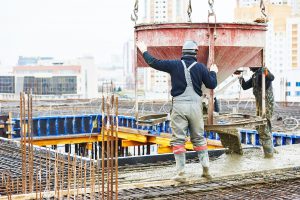One of the jobs commonly taken by concrete contractors is column strengthening. This is a process used to add or restore the ultimate load capacity of reinforced concrete columns. It is used for seismic retrofitting, supporting additional live load or dead load that is not included in the original design, to relieve stresses generated by design or construction errors, or to restore original load capacity to damaged structural elements.
There are several techniques that are used to strengthen reinforced concrete columns in construction like reinforced concrete jacketing, steel jacketing, and FRP confining or jacketing. And today, we will take a quick look at how concrete contractors are improving the strength of structural columns.
But when is strengthening of Reinforced Concrete Columns really needed?
- When the load carried by the column is increased due to either increase the number of floors or due to mistakes in the design.
- When the compressive strength of the concrete or the percent and type of reinforcement are not according to the codes’ requirements.
- When the inclination of the column is more than the allowable.
- When the settlement in the foundation is more than the allowable.
Strengthening Techniques for Reinforced Concrete Columns
There are three major techniques used by concrete contractors for strengthening reinforced concrete columns which are discussed below:
Reinforced Concrete Jacketing
It is one of the techniques used to improve or restore the capacity of the reinforced concrete columns. The size of the jacket and the number and diameter of the steel bars used in the jacketing process depend on the structural analysis that was made to the column.
Reinforced Concrete Jacketing Process:
- Initially, reduce or eliminate loads on columns temporarily if it is required. This is done by putting mechanical jacks and additional props between floors.
- After that, if it is found out that reinforcements are corroded, remove the concrete cover and clean the steel bars using a wire brush or sand compressor.
- Then, coat the steel bars with an epoxy material that would prevent corrosion.
- If reducing loads and cleaning reinforcement is not needed, the jacketing process begins by adding steel connectors into the existing column.
- The steel connectors are added into the column by making holes 3-4mm larger than the diameter of the used steel connectors and 10-15cm depth.
- The spacing of new stirrups of the jacket in both the vertical and horizontal directions should not be more than 50cm. Filling the holes with an appropriate epoxy material then inserting the connectors into the holes.
- Adding vertical steel connectors to fasten the vertical steel bars of the jacket following the same two prior procedures.
- Installing the new vertical steel bars and stirrups of the jacket according to the designed dimensions and diameters.
- Coating the existing column with an appropriate epoxy material that would guarantee the bond between the old and new concrete.
- Pouring the concrete of the jacket before the epoxy material dries. The concrete used should be of low shrinkage and consists of small aggregates, sand, cement, and additional materials to prevent shrinkage.
Steel Jacketing
This technique is chosen when the loads applied to the column will be increased, and at the same time, increasing the cross-sectional area of the column is not permitted.
Steel Jacketing Process
- Removing the concrete cover.
- Cleaning the reinforcement steel bars using a wire brush or a sand compressor.
- Coating the steel bars with epoxy material that would prevent corrosion.
- Installing the steel jacket with the required size and thickness, according to the design, and making openings to pour through them the epoxy material that would guarantee the needed bond between the concrete column and the steel jacket.
- Filling the space between the concrete column and the steel jacket with an appropriate epoxy material.
In some cases, where the column is needed to carry bending moment and transfer it successfully through the floors, one should install a steel collar at the neck of the column by means of bolts or suitable bonding material.
FRP Confining or Jacketing
Fiber-reinforced plastic (FRP) axial strengthening systems are used to improve or enhance the capacity of reinforced concrete columns. It can be used for both circular and rectangular-shaped columns but it is more effective in the former shape.
FRP axial strengthening is usually conducted by providing fiber-reinforced polymer (FRP) around reinforced concrete columns. This strengthening technique is specifically influential when the column is circular.
However, if the reinforced concrete column is rectangular and the ratio of depth to width of a column is larger than 2 or the smallest side of the column is greater than 900mm, then ACI 440.2R-08 is not applied for this strengthening method.
The ineffectiveness of rectangular or square column confinement might be attributed to the non-uniform stress distribution and stress concentration at the corner of the section. This may lead to premature failure of the strengthened element.
It is essential to wrap reinforced concrete columns completely with FRPs in order to confine and improve the element effectively. Unlike the flexural and shear strengthening of reinforced concrete beams, the FRPs which surround the column and activated only if the member is enlarged laterally and exert stresses on the FRPs. This means that beam strengthening is an active system whereas column strengthening is a passive system.
Final Thoughts
Placing reinforced bars in concrete columns can make it a stronger unit but there are more ways concrete contractors use to further their durability. The items above are just some of the techniques that they apply in construction.
Starting out your column strengthening project? Use Pro Crew Schedule concrete contractor software to help you manage your projects and achieve greater results that can win you more bids in the future.






2 thoughts on “3 Ways To Strengthen Reinforced Concrete in Construction”
It’s a pity you don’t have a donate button! I’d most certainly
donate to this outstanding blog! I suppose for now
i’ll settle for book-marking and adding your RSS
feed to my Google account. I look forward to brand new updates and will
talk about this site with my Facebook group. Chat soon!
Thank you! Please subscribe to our newsletter to get the latest news and updates from Pro Crew Schedule.